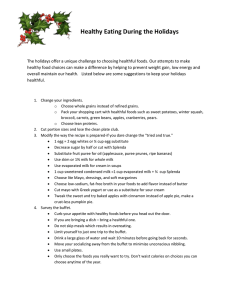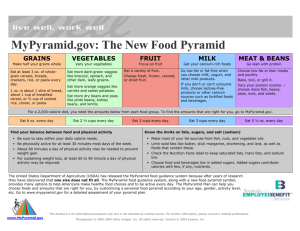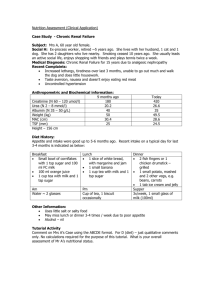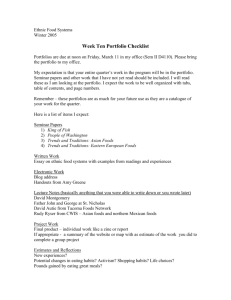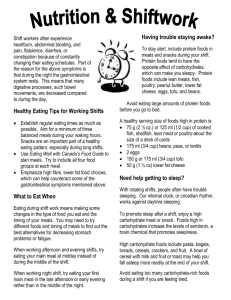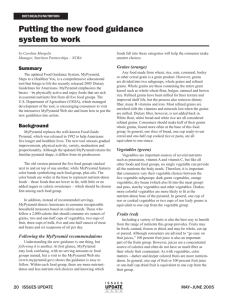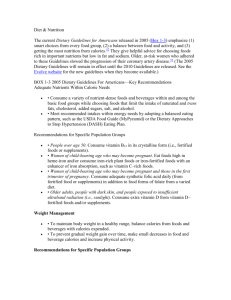Maintenance - Dean Health System
advertisement
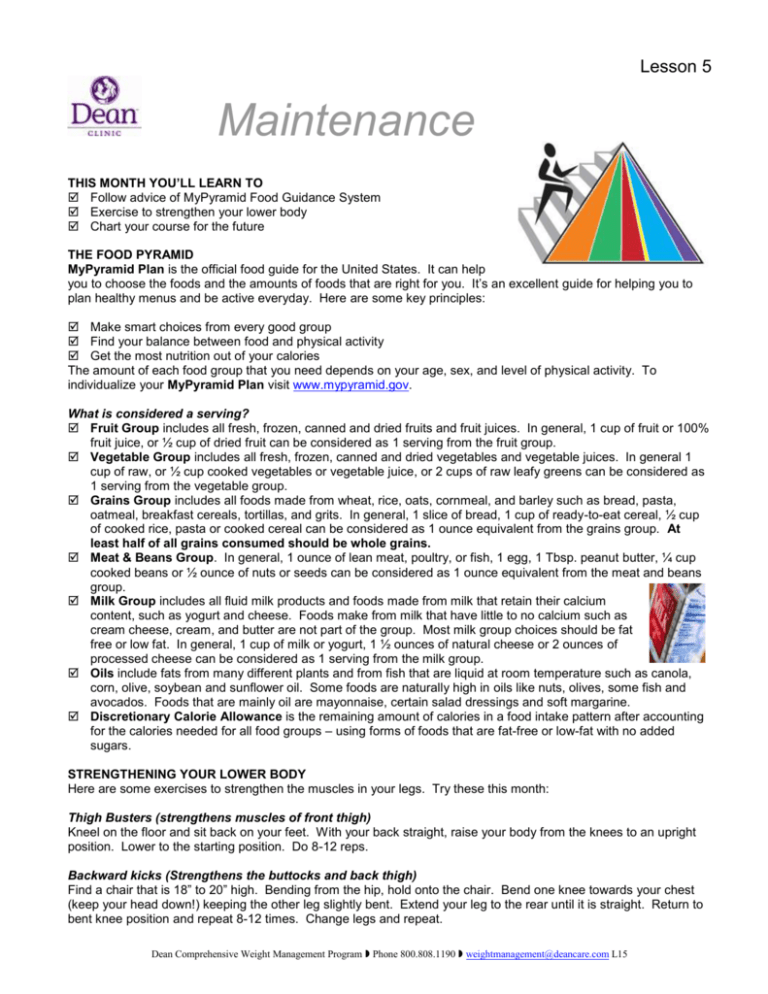
Lesson 5 Maintenance THIS MONTH YOU’LL LEARN TO Follow advice of MyPyramid Food Guidance System Exercise to strengthen your lower body Chart your course for the future THE FOOD PYRAMID MyPyramid Plan is the official food guide for the United States. It can help you to choose the foods and the amounts of foods that are right for you. It’s an excellent guide for helping you to plan healthy menus and be active everyday. Here are some key principles: Make smart choices from every good group Find your balance between food and physical activity Get the most nutrition out of your calories The amount of each food group that you need depends on your age, sex, and level of physical activity. To individualize your MyPyramid Plan visit www.mypyramid.gov. What is considered a serving? Fruit Group includes all fresh, frozen, canned and dried fruits and fruit juices. In general, 1 cup of fruit or 100% fruit juice, or ½ cup of dried fruit can be considered as 1 serving from the fruit group. Vegetable Group includes all fresh, frozen, canned and dried vegetables and vegetable juices. In general 1 cup of raw, or ½ cup cooked vegetables or vegetable juice, or 2 cups of raw leafy greens can be considered as 1 serving from the vegetable group. Grains Group includes all foods made from wheat, rice, oats, cornmeal, and barley such as bread, pasta, oatmeal, breakfast cereals, tortillas, and grits. In general, 1 slice of bread, 1 cup of ready-to-eat cereal, ½ cup of cooked rice, pasta or cooked cereal can be considered as 1 ounce equivalent from the grains group. At least half of all grains consumed should be whole grains. Meat & Beans Group. In general, 1 ounce of lean meat, poultry, or fish, 1 egg, 1 Tbsp. peanut butter, ¼ cup cooked beans or ½ ounce of nuts or seeds can be considered as 1 ounce equivalent from the meat and beans group. Milk Group includes all fluid milk products and foods made from milk that retain their calcium content, such as yogurt and cheese. Foods make from milk that have little to no calcium such as cream cheese, cream, and butter are not part of the group. Most milk group choices should be fat free or low fat. In general, 1 cup of milk or yogurt, 1 ½ ounces of natural cheese or 2 ounces of processed cheese can be considered as 1 serving from the milk group. Oils include fats from many different plants and from fish that are liquid at room temperature such as canola, corn, olive, soybean and sunflower oil. Some foods are naturally high in oils like nuts, olives, some fish and avocados. Foods that are mainly oil are mayonnaise, certain salad dressings and soft margarine. Discretionary Calorie Allowance is the remaining amount of calories in a food intake pattern after accounting for the calories needed for all food groups – using forms of foods that are fat-free or low-fat with no added sugars. STRENGTHENING YOUR LOWER BODY Here are some exercises to strengthen the muscles in your legs. Try these this month: Thigh Busters (strengthens muscles of front thigh) Kneel on the floor and sit back on your feet. With your back straight, raise your body from the knees to an upright position. Lower to the starting position. Do 8-12 reps. Backward kicks (Strengthens the buttocks and back thigh) Find a chair that is 18” to 20” high. Bending from the hip, hold onto the chair. Bend one knee towards your chest (keep your head down!) keeping the other leg slightly bent. Extend your leg to the rear until it is straight. Return to bent knee position and repeat 8-12 times. Change legs and repeat. Dean Comprehensive Weight Management Program Phone 800.808.1190 weightmanagement@deancare.com L15 Lesson 5 Maintenance LETTING GO, MOVING FORWARD Building health habits takes time! At first, the ‘novelty’ of the new behavior can feel exciting and motivating. But, after a while, the novelty wears off and so does the motivation. At this point, many describe feeling in a state of ‘limbo’. They haven’t done the new habits long enough to make them feel routine, but the habits are familiar enough so the newness is gone. During times of limbo, it’s enticing to go back to old, familiar (known & comfortable) ways, even if they promote weight gain and an unhealthy lifestyle. But to move forward, to choose change, demands action and assertiveness even when it feels awkward and uncomfortable to do so. It means consciously choosing to let go of old behaviors (watching TV every night), activities (Wednesday night “All you can eat” buffets), and sometimes friends (who only want to eat when you get together). When limbo strikes, use visualization to ‘see the new you’ successfully practicing your new habits. Remember, you are what you see and think! As you choose to let go of old ways, expect that you’ll have some feelings of loss and sadness. Hobbies, exercise, and supportive friends can be life jackets during this choppy sea of change. Remember, reaching for help is a sign of strength, not weakness. To assure that your ship is charting a healthy course, complete the following exercise. ACTIVITY By now, you’ve likely identified the behaviors that hinder and help your weight maintenance efforts. In the KEEP column below, list behaviors, activities, and friends that currently support your new, healthy lifestyle. In the LET GO column, list those that currently hinder your new, healthy habits. In the GET MORE OF, list those you are not doing but you know support your healthy lifestyle. As indicated by their titles, in the next month plan to continue with the KEEP items, discontinue the LET GO items, and obtain the GET MORE OF items! KEEP LET GO GET MORE OF \\DHS\DFS\GROUPS\ADMINISTRATION\DHS\SHARP\HELPING OUT\WEIGHT MGMT\LESSON 5 MAINTENANCE.DOC Dean Comprehensive Weight Management Program Phone 800.808.1190 weightmanagement@deancare.com L15
